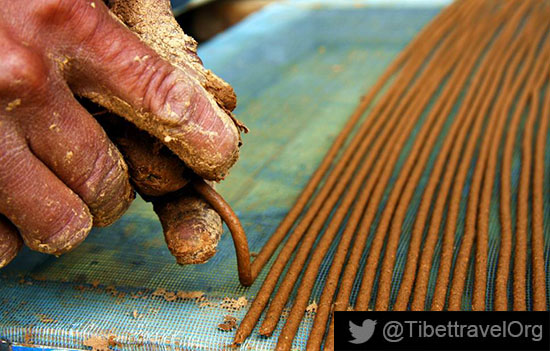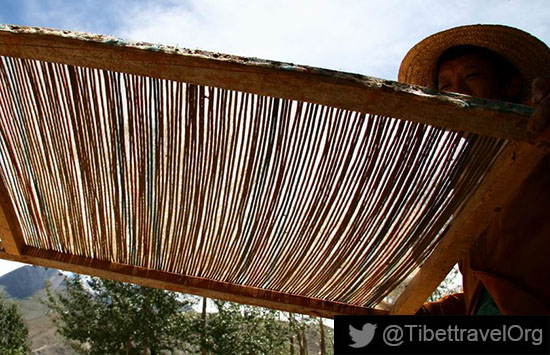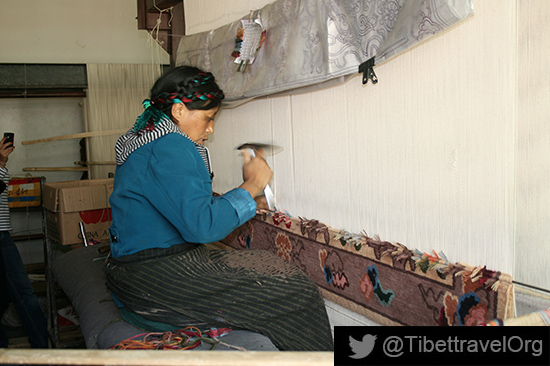With a long history, Tibetan handicrafts mirror Tibet’s economic and cultural development. They are not only highly practical, but also have great aesthetic value. Thus, we highly advise you to spare some time to learn more about them. This tour will take you to see how Tibetan incense and Tibetan carpet are made. They are two significant kinds of handicrafts in Tibet. Learning about them, you will have a better understanding of Tibet’s culture and local people’s life.Tunba town, Nyemu county of Lhasa, is an important incense production area which produces Tunna Tibetan incense. Tunba incense is one of the best known local products of Tibet.
The town is accessible by highway No. 318 and is 20 km from Nyemu county and 110 km from Lhasa. It has many spots related to incense production. It is also the hometown of Tumi sambadha, founder of Tibetan script.There are three kinds of Tibetan carpet. The first kind is made of fine hair of yak and knitting wool, with colorful and complicated design and light in weight. The second kind is made of fine wool of sheep, with simple design, including some more complex designed thin blanket made of colorful wool.
 Tibetan Incense usually refers to a common style of incense found in Tibet, Northern parts of Nepal, and Bhutan. The incense is an important representation of the Tibetan culture. Tibetan incenses can contain 30 or more ingredients. Tibetan incense is different from other incense as it does not have a stick inside it, making the incense purer. In Tibetan medical field, Tibetan incense is recognized as a way of treatment for sickness.
Tibetan Incense usually refers to a common style of incense found in Tibet, Northern parts of Nepal, and Bhutan. The incense is an important representation of the Tibetan culture. Tibetan incenses can contain 30 or more ingredients. Tibetan incense is different from other incense as it does not have a stick inside it, making the incense purer. In Tibetan medical field, Tibetan incense is recognized as a way of treatment for sickness. Thangka Thangka is a Nepalese art form exported to Tibet in 7th .it is a painting on cotton, or silk, usually depicting a Buddhist deity, scene, or Mandala of some sort. Thangka, when created properly, perform several different functions. Images of deities can be used as teaching tools when depicting the life of the Buddha, describing historical events concerning important Lamas, or retelling myths associated with other deities.
Thangka Thangka is a Nepalese art form exported to Tibet in 7th .it is a painting on cotton, or silk, usually depicting a Buddhist deity, scene, or Mandala of some sort. Thangka, when created properly, perform several different functions. Images of deities can be used as teaching tools when depicting the life of the Buddha, describing historical events concerning important Lamas, or retelling myths associated with other deities.
 Tibetan Carpet: There are three kinds of Tibetan carpet. The first kind is made of fine hair of yak and knitting wool, with colorful and complicated design and light in weight. The second kind is made of fine wool of sheep, with simple design, including some more complex designed thin blanket made of colorful wool. The third kind is Kadiam, namely, cushion. This kind of cushion is to put hair of river deer, barley stalk or dry grass in canvas or yak skin, which is of solid quality. If the above are matched well, they are ideal decoration to a house.
Tibetan Carpet: There are three kinds of Tibetan carpet. The first kind is made of fine hair of yak and knitting wool, with colorful and complicated design and light in weight. The second kind is made of fine wool of sheep, with simple design, including some more complex designed thin blanket made of colorful wool. The third kind is Kadiam, namely, cushion. This kind of cushion is to put hair of river deer, barley stalk or dry grass in canvas or yak skin, which is of solid quality. If the above are matched well, they are ideal decoration to a house.
Duration: 1 Day (Starts from9:00 am, finishes around6:00 pm.).
Tour Type: private tour.
Attractions: Linkhor road, Traditional Resident area.
Dining: Lunch.
Accommodation: included.
Service: Hotel pick-up&drop-off service, private vehicle and Tibetan English-speaking tour guide.
Itinerary Start from the hotel, visit the Tibetan incense workroom and Thangka workroom.
Pick up at the hotel, take a deep visit to a Tibetan incense workroom in the morning try to learn what kind of ingredients the incense needs, and how to make a incense stick by yourself. After lunch, take a visit to a Thangka workroom learn what Thangka is, what it used for and how to draw it.
After the tour, we will drop you off at your hotel.
 Tibetan Incense usually refers to a common style of incense found in Tibet, Northern parts of Nepal, and Bhutan. The incense is an important representation of the Tibetan culture. Tibetan incenses can contain 30 or more ingredients. Tibetan incense is different from other incense as it does not have a stick inside it, making the incense purer. In Tibetan medical field, Tibetan incense is recognized as a way of treatment for sickness.
Tibetan Incense usually refers to a common style of incense found in Tibet, Northern parts of Nepal, and Bhutan. The incense is an important representation of the Tibetan culture. Tibetan incenses can contain 30 or more ingredients. Tibetan incense is different from other incense as it does not have a stick inside it, making the incense purer. In Tibetan medical field, Tibetan incense is recognized as a way of treatment for sickness. Thangka Thangka is a Nepalese art form exported to Tibet in 7th .it is a painting on cotton, or silk, usually depicting a Buddhist deity, scene, or Mandala of some sort. Thangka, when created properly, perform several different functions. Images of deities can be used as teaching tools when depicting the life of the Buddha, describing historical events concerning important Lamas, or retelling myths associated with other deities.
Thangka Thangka is a Nepalese art form exported to Tibet in 7th .it is a painting on cotton, or silk, usually depicting a Buddhist deity, scene, or Mandala of some sort. Thangka, when created properly, perform several different functions. Images of deities can be used as teaching tools when depicting the life of the Buddha, describing historical events concerning important Lamas, or retelling myths associated with other deities.
 Tibetan Carpet: There are three kinds of Tibetan carpet. The first kind is made of fine hair of yak and knitting wool, with colorful and complicated design and light in weight. The second kind is made of fine wool of sheep, with simple design, including some more complex designed thin blanket made of colorful wool. The third kind is Kadiam, namely, cushion. This kind of cushion is to put hair of river deer, barley stalk or dry grass in canvas or yak skin, which is of solid quality. If the above are matched well, they are ideal decoration to a house.
Tibetan Carpet: There are three kinds of Tibetan carpet. The first kind is made of fine hair of yak and knitting wool, with colorful and complicated design and light in weight. The second kind is made of fine wool of sheep, with simple design, including some more complex designed thin blanket made of colorful wool. The third kind is Kadiam, namely, cushion. This kind of cushion is to put hair of river deer, barley stalk or dry grass in canvas or yak skin, which is of solid quality. If the above are matched well, they are ideal decoration to a house.
Local villagers extrude the mixture of cypress flour and Tibetan medicine into slender strips by yak horns
with a hole, and then dry those strips in the air or sunshine.
with a hole, and then dry those strips in the air or sunshine.

To dry Tibetan Incense in the sunshine

Worker is making Tibetan Carpet
 BACK
BACK

0 Comment ON ""